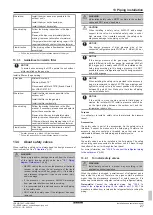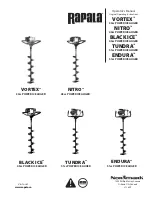
13 Piping installation
Installation and operation manual
29
LREN8~12A7 + LRNUN5A7
CO
₂
ZEAS outdoor unit and capacity up unit
4P704141-1B – 2022.12
13.5.1
Checking refrigerant piping: Setup
E
a
N2
R744
a
b
b
C
A
B
D
ch id
e
g
b
f
A
Nitrogen (N
2
)
B
R744 refrigerant tank
C
Weighing scales
D
Vacuum pump
E
Outdoor unit
a
Pressure regulator
b
Charge hose
c
Service port SP3 (gas side)
d
Service port SP7 (liquid side)
e
Service port SP11 (gas side)
f
To refrigeration indoor unit
g
Safety valve
h
Stop valve (gas side)
i
Stop valve (liquid side)
Stop valve
Service port
Field piping
NOTICE
The connections to the indoor units and all indoor units
should also be leak and vacuum tested. Keep any possible
(field supplied) field piping valves open as well.
Also see the indoor unit installation manual for more
details. Leak test and vacuum drying should be done
before the power supply is set to the unit.
13.5.2
To perform a strength pressure test and
leak test
The test must satisfy the specifications of EN378‑2.
Prerequisite:
To prevent the safety valve from opening during the
test, do the following:
▪ Remove the safety valve(s) and, if present, the changeover
valve.
▪ Install a cap (field supplied) onto the treaded piece.
1
Connect to the gas side (c) (e) and liquid side (d). See
"13.5.1 Checking refrigerant piping: Setup"
2
Pressurise both liquid side and gas side from service ports SP3,
SP7 and SP11. Always test the pressure according to EN378-2
and mind the set pressure of the pressure relief valve (if
installed). Recommended test pressure for the liquid and the
gas side: 1.1 Ps (99 bar gauge).
3
Make sure there is no pressure drop.
4
If there is a pressure drop, locate the leak, repair it and repeat
the test.
13.5.3
To perform vacuum drying
1
Connect a vacuum pump to service ports SP3, SP7 and SP11.
See
"13.5.1 Checking refrigerant piping: Setup"
2
Vacuum the unit for at least 2 hours and to –100.7 kPaG
(-1.007 bar gauge) or below.
3
Leave the unit for more than 1 hour with a vacuum pressure of
–100.7 kPaG (-1.007 bar gauge) or less. On the vacuum gauge,
check if the pressure does not increase. If the pressure rises,
the system has a leak or moisture remained into the piping.
4
If the test was successful, replace the cap on the threaded
piece with the changeover valve (if applicable) and safety
valve(s).
WARNING
To ensure that the safety valve(s) and the changeover
valve are properly reinstalled, a leak test is mandatory.
In case of a leak
1
Find and repair the leak.
2
When done, perform the leak test and vacuum test again. See
"13.5.2 To perform a strength pressure test and leak
test"
"13.5.3 To perform vacuum drying"
In case of remaining moisture
When the unit is installed on rainy days, moisture may still remain in
the piping after a first vacuum drying is performed. If so, conduct the
following procedure:
1
Pressurise the nitrogen gas up to 0.05 MPa (for vacuum
destruction) and vacuum for at least 2 hours.
2
Afterwards, vacuum dry the unit to –100.7 kPaG (-1.007 bar
gauge) or less for at least 1 hour.
3
Repeat vacuum destruction and vacuum drying if the pressure
does not reach –100.7 kPaG (-1.007 bar gauge) or less.
4
Leave the unit for more than 1 hour with a vacuum pressure of
–100.7 kPaG (-1.007 bar gauge) or less. On the vacuum gauge,
check if the pressure does not increase.
13.6
Insulating the refrigerant piping
After finishing the leak test and vacuum drying, the piping must be
insulated. Take into account the following points:
▪ Be sure to insulate the liquid and gas piping (for all units).
▪ For liquid and gas piping: Use heat resistant polyethylene foam
which can withstand a temperature of 70°C.
Insulation thickness
Take the following into account when determining the insulation
thickness:
Piping
Minimum temperature during
operation
Liquid piping
0°C
Gas piping
–40°C
Depending on your local weather conditions, you may need to
increase the thickness of the insulation. If the ambient temperature
exceeds 30°C and the humidity exceeds 80%.
▪ Increase the thickness of the liquid piping with ≥5 mm
▪ Increase the thickness of the gas piping with ≥20 mm
Insulation sealing
To prevent rain and condensed water entering the unit, add a
sealing between the insulation and the front panel of the unit.
Содержание LREN8A7Y1B
Страница 50: ......
Страница 51: ......
Страница 52: ...4P704141 1B 2022 12 Copyright 2022 Daikin 4P704141 1 B 0000000V Verantwortung f r Energie und Umwelt...
















































